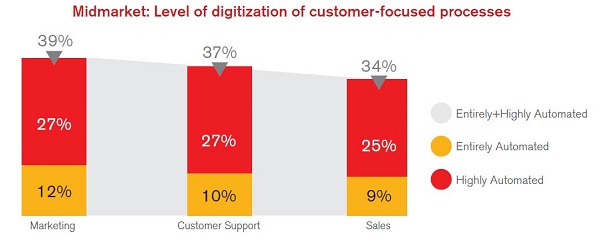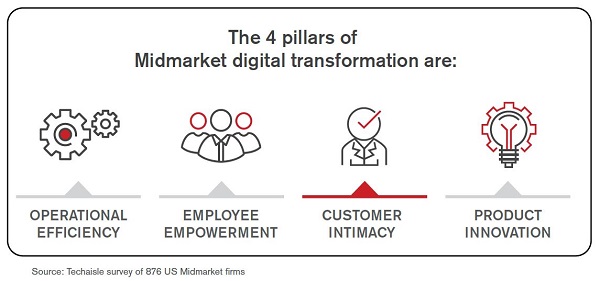Techaisle Blog
Digital transformation and customer intimacy in modern midmarket – 3rd pillar of DX
A Techaisle survey of nearly 900 midmarket firms in the US found that 41% of midmarket firms believe digital technologies impact every aspect of the business and are a core part of organizational strategy and more than one-third of midmarket businesses – 34% - believe that digital transformation is a key to customer intimacy. Executives are surrounded by examples of organizations that are using data – drawn from integrated internal systems, or from social media, or from far-flung sensors, or from third party services, or from a mix of all of these sources – to improve the key operating parameters of their businesses. Midmarket firms anticipate 21% improvement in upsell/cross-sell, 20% improvement in brand image and 19% improvement in customer satisfaction as outcomes of a successful DX strategy.
DX-enabled organizations generate more revenue from cross-sell/upsell; they have greater customer loyalty; they are able to open new markets and introduce new products and services faster and with better payback periods. And they do this through customer intimacy – by better understanding what their clients want and need, and by being agile in responding to these wants and needs. Techaisle research finds, in fact, that performance metrics that are tied to customer intimacy – improved upsell/cross-sell of products, improved brand image, and better customer satisfaction and retention – are the areas expected to improve the most as a result of digital transformation in the organization.
The constraints
Building customer intimacy is a little bit like making Baked Alaska: the promise is delicious, but the method is mysterious. With Baked Alaska, it’s the notion that ice cream can emerge from an oven unmelted. With customer intimacy, it’s the mystery of how to successfully aggregate data and integrate it with customer-facing activities.
Data integration is clearly a key impediment to customer intimacy. DX, which can be defined as “integrating digitalized processes to achieve enterprise-wide automation or modernizing current processes and infrastructure to achieve previously-unattainable outcomes, can be seen as the final step in a three-stage process. Step one is digitization – the conversion of manual/paper records, data or processes into a digital format. Step two is digitalization – using digital technologies to automate processes, and using the resulting digital information for better business outcomes. The allure of DX-driven customer intimacy is as enticing as the flame wreathing a Baked Alaska, but it requires that data from across the organization be transformed into useable digital formats, and that processes the aligned with the need to create digital pathways that clarify current performance levels and opportunities for improvement.
This kind of transformation is difficult to achieve in front-office functions: the data needed to support change is hard to collect and transform into useful insight, staff often act more on ‘feel’ than on fact, and customer expectations are affected by social media input, experiences with your organization and/or a competitor, or by a host of other inputs. Techaisle research has found that as a result, some of the functions that are most critical to customer intimacy are also the ones that are least ready for DX: fewer than 40% of midmarket firms consider marketing, customer support and (especially) sales to be “entirely” or “highly” digitized. Without achieving this first step, the longer journey to DX-driven customer intimacy is impossible to navigate.
Bridging the gap
Macy’s founder John Wanamaker famously observed that “half the money I spend on advertising is wasted; the trouble is I don’t know which half.” Contemporary research expands on this thought, with a Forbes magazine article proclaiming that “Wanamaker was wrong – the vast majority of advertising is wasted,” and an online B2B Marketing site rejoining that if Wanamaker was still with us today, “he would have his answers…he would be able to accurately and precisely measure” the ROI of customer-facing activity.
These answers aren’t simply a result of having technology within an organization. Customer intimacy results from an ability to link technology (and the data it collects, shares and enhances) with front-line functions. This in turn requires an understanding of both how to develop DX technical competencies and how to integrate them within the organization. Midmarket executives – and the IT management within these organizations – will look to trusted advisors for the approaches that link IT investments and business priorities to these objectives.
The journey from IT systems to customer intimacy isn’t a matter of magical alchemy that wreathes unlikely ingredients with an alluring halo. It is the end result of a roadmap that starts with digitizing data and processes, moves forward through connected systems that encourage and support fact-based customer-facing activity, and result in an organizational capacity to understand and respond to customer needs. Midmarket businesses understand the appeal of the outcome – and they need guidance from a channel that can define the recipe for DX-enable customer intimacy.
Senior executives in midmarket organizations care about digital transformation – and as a result, channel members can leverage their understanding of key Digital transformation objectives and roadmaps into long-term, sustainable relationships with senior decision makers.













